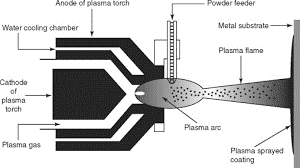How does Thermal spray powder work?
Thermal spray
coatings are made up of molten powder and wire burned with plasma or oxygen.
When thermal spray powder is sprayed on a mixture of metal, it forms a hard
coating. Thermal spray coating powder is used on vehicles, buildings, and other
structures. They defend the structure from chemical and weather components like
rain, severe temperature, moisture or humidity.
In thermal
spraying, materials are heated/melted and sprayed on the surface. They are
heated using electrical or chemical methods. Thermal spraying produces thick
coatings on the material. The coated materials like metals, polymers, ceramics
and other composites are applied in thermal spraying. Thermal spray powder suppliers use electric arc current or combustion to produce energy. Thermal spray
powder repairs damaged and worn-out parts of a machined structure. Thermal
spray coatings restore corroded parts of an object.
Types of Thermal Spraying Process.
Spray and Fuse
Plasma spraying
Flame spraying
Cold Spraying
How does thermal spray powder work?
Thermal spray
powder processes an extensive class of coating methods where the materials are
heated and sprayed on the surface. Thermal spray powder is used to coat
engineering components, protecting the structure from corrosion, high
temperatures and extreme weather conditions.
Thermal spraying
processes are extremely flexible and versatile. They can be used on any metal,
plastics, ceramics or composites. Choosing a suitable thermal spray powder is
essential. The shape and size distribution of thermal spray powder has a
notable effect on the quality of the coating. Dissimilar particle distribution
will lead to structural differences.
Process of producing thermal spray powder.
Atomization
Molten metal is
sprayed to build tiny droplets. These droplets dry and solidify into a powder.
Metal powders in the atomization process include iron, titanium, stainless
steel, aluminum, zinc, bronze, copper, alloys, nickel, and tin.
Chemical
Chemical techniques
involve dissolving oxides, calcining, and heat treating. Oxide-generated
powders have a soaked state because of the pores in particles. Thermal spray powder suppliers use chemical treatments to produce the
purest form of thermal spray powder. They have a high percentage level of purity.
Solid state reduction
In a solid-state
reduction method, the ore is mixed and crushed with other materials like carbon
and processed through a furnace, which forms a metal cake. The metal cake is
crushed into fine powders. This technique can take up to 3 days to produce
thermal spray powders.
Spray drying
Fine unprocessed
materials are assembled in the form of a water or solvent liquid base. These
liquid solvents are further sprayed into droplets through rotating wheels or
high-velocity gas. These droplets are evaporated by hot air or processed gas to
create fine particles. This technique builds free-flowing, spherical thermal
spray powders.
Conclusion:
Thermal spray
powder is applied on the material surface to protect the structure from
corrosion and extreme weather conditions. They build chemical resistance, high
or low friction, electrical insulation and lubricity. We have discussed in this
article how thermal spray powders are built and the techniques used to produce
them.




Comments
Post a Comment